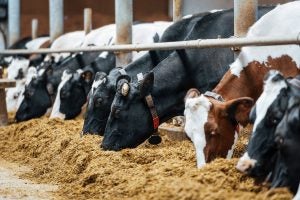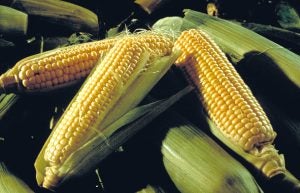Animal-rights activist & vegan/vegetarians constantly repeat the myth that we could feed more people if we stopped feeding cows. However, this isn’t really the case, and I’ll explain why.
Beef cattle take about 2.6 pounds of grain for every pound of meat they produce. Each year, we feed out over 14 million head of “finisher” fat cattle going to market, but only 7 percent of the grain that’s produced is fed to cattle! The rest goes to chickens, pigs, and other animals (including your dogs and cats), and also to feed you! Feed, seed, and industrial use of corn accounts for about a third of production, 20 percent goes or global export, and about 40 percent of field corn is used for ethanol production, which helps reduce the need for fossil fuels — this one biofuel has a carbon footprint that is 43 percent lower than gasoline.
So, if we stopped feeding cattle, we would have 8 million more acres of corn for human uses, but is there really a need for more filler- or “junk food”-type products? I doubt it.

Seventy-five percent of the Midwest’s agricultural lands are currently planted in corn or soybeans — the region known as America’s Corn Belt. Why? It’s the best growing conditions for these types of products based on climate, resilience, soil type, topography, mechanization, etc. So if it brings the best opportunity to grow it, why can’t we use the acreage to feed humans instead of cows? Well, it may take 2.6 pounds of grain to get 1 pound of beef, but we get a whole lot more nutrition out of beef than we do grain corn. Not to mention a multitude of great byproducts.
Infrastructure also plays a role. Given the importance of grain in this region, not much infrastructure has been invested for other crops, and farmers have to have a place to sell their commodities.
One super-power of cattle is that they can turn inedible products into delicious steaks and other nutritional food items. Cows generally eat grass in the first half of their life and byproducts from other industries in their grain rations in the feed lot. Byproducts could include citrus pellets, cottonseed hulls, or distillers grains from alcohol productions. These products would otherwise go to waste in a landfill, contributing to greenhouse gases as they decompose.
Cows turn these otherwise worthless materials into a nutrition powerhouse. One three-ounce serving of beef provides over half of the recommended daily amount of protein, along with critical vitamins and minerals like selenium, zinc, B12, phosphorus, niacin, and others. Best of all, beef is relatively low-calorie, with only 173 calories in a three-ounce serving. Overall, beef provides 10 essential nutrients to your body, whereas corn can barely compete.
Processed corn products are not as nutritious since the cooking and processing can break down nutrients, and there may be added fats, sugars, or salts included in the final product. Fresh sweet corn, or the whole cob/kernel varieties we typically eat are not generally grown in large quantities in the Midwest where grain corn dominates. States such Florida, California, Washington, New York, and Georgia are meeting demand for fresh corn, so there isn’t much possibility to plant sweet corn on the 8 million acres we mentioned earlier. Fun fact: Sweet corn only accounts for about 1 percent of U.S. corn acreage.

In the end, cattle are upcyclers. Yes they utilize land, water, a little bit of fuel, and of course grains, but the end result is well worth it. Cattle provide so much more than just meat: They hold space for natural areas, utilization and management of rangelands that help sequester carbon and recharge water aquifers, and allow areas for recreation, hunting, and native wildlife to thrive. Removing beef from the diet would reduce green house gases by only 1.9 percent, and this number could drastically reduce once you figure in the replacement of beef’s nutritive value on the dinner plate with other crops or animal products and the increased GHG from their increase in production.
Don’t feel guilty about what you choose to fuel your body with. Beef is an amazing resource and removing it from your diet won’t help the planet or you.
Michelle Miller, the Farm Babe, is a farmer, public speaker, and writer who has worked for years with row crops, beef cattle, and sheep. She believes education is key in bridging the gap between farmers and consumers.



